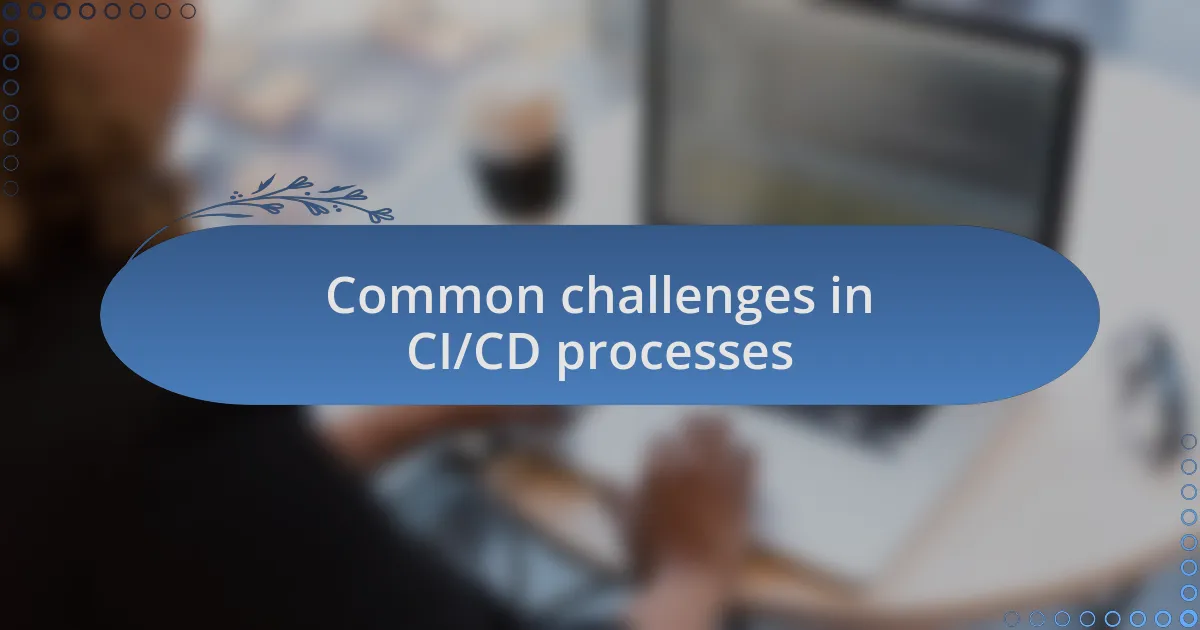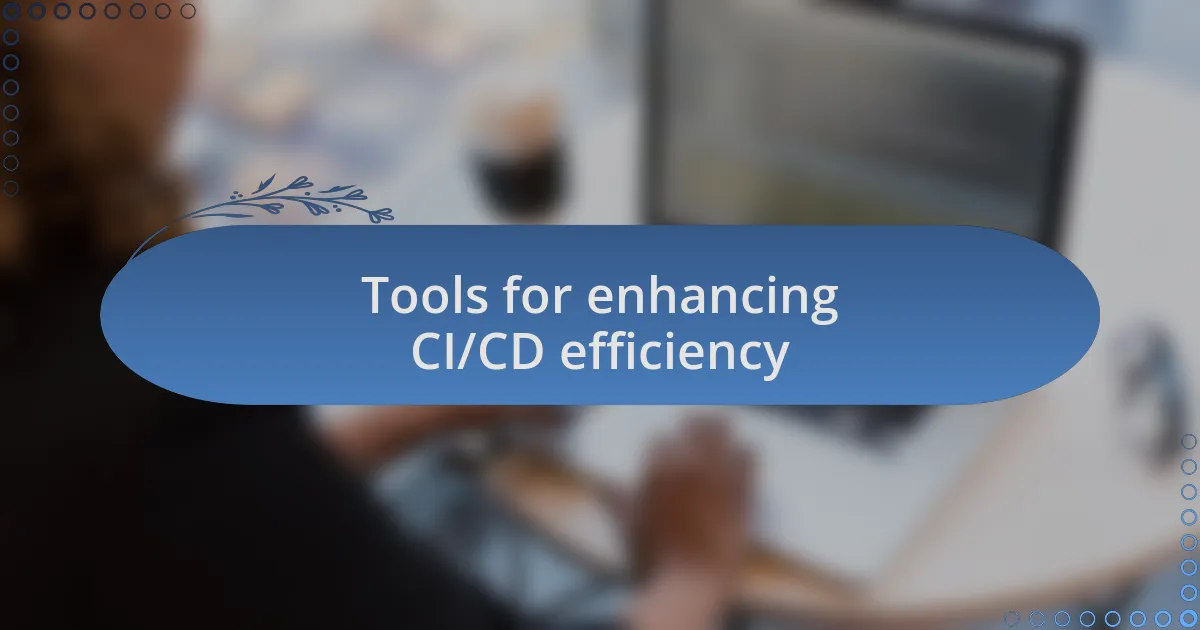Key takeaways:
- Continuous Integration (CI) enables early detection of issues through frequent code merges, while Continuous Deployment (CD) automates releases, enhancing efficiency and reducing chaos during deployment.
- Common challenges in CI/CD include tool integration issues, resistance to cultural shifts, and maintaining code quality amid rapid deployments.
- Strategies to improve CI/CD processes include embracing automation, utilizing containerization for consistent environments, and fostering a culture of continuous improvement through retrospectives.
- Key tools for enhancing CI/CD efficiency are robust version control systems like Git, automation tools like Jenkins, and monitoring solutions like Prometheus and Grafana.

Understanding CI/CD concepts
Continuous Integration (CI) and Continuous Deployment (CD) are foundational concepts in modern development. CI is about merging code changes into a shared repository frequently, allowing for early detection of issues. I remember a project where we integrated CI practices, and the quick feedback loops dramatically reduced our debugging time.
On the other hand, CD takes that a step further by automating the release of code changes to production. This practice allows teams to deliver updates to users more efficiently and with less risk. I used to dread the release days filled with chaos and uncertainty, but implementing CD turned those moments into smooth transitions, fostering a sense of confidence and reliability within the team.
These concepts not only improve the technical workflow but also enhance collaboration among team members. Have you ever found yourself stuck in a cycle of endless code reviews or last-minute fixes? By adopting CI/CD practices, my team and I transformed our approach, turning what was once a frustrating process into a streamlined, continuous flow that encouraged innovation and creativity.

Common challenges in CI/CD processes
One common challenge in CI/CD processes is the integration of tools and technologies. I recall a time when our team wrestled with incompatible software solutions, which led to frequent breakdowns in the pipeline. It felt like building a beautiful structure only to have the scaffolding collapse every time we tried to deploy. Have you ever faced a similar situation, where the tools meant to help you instead became a hurdle?
Another hurdle often encountered is the culture shift required for successful CI/CD implementation. I remember the initial reluctance from some team members who were used to traditional methods. This resistance can create friction and slow down progress. How can we encourage a mindset open to change? I found that emphasizing the benefits of faster feedback and fewer bottlenecks helped ease the transition, creating a more unified team atmosphere.
Lastly, ensuring code quality during the rapid deployment cycle poses its own set of challenges. I once worked on a project where the push for speed compromised our testing rigor, leading to bugs sneaking into production. It was a frustrating wake-up call that reminded me of the importance of balancing speed with quality. How can we maintain that crucial equilibrium? Establishing stringent automated tests and code reviews made a massive difference in maintaining our standards while still benefiting from quick deployments.

Strategies for streamlining CI/CD
One effective strategy for streamlining CI/CD is to embrace automation across the board. In my experience, when we implemented automated testing and deployment scripts, it felt like lifting a burden off our shoulders. I remember the first time we watched a successful deployment happen at the click of a button—a true game-changer. Have you ever felt that relief when technology finally works for you, instead of against you?
Another approach I’ve found invaluable is the use of containerization. By deploying our applications in containers, we achieved consistent environments from development to production. I recall the day we migrated to Docker; those once frustrating issues of “but it worked on my machine” vanished. Doesn’t it feel great when you eliminate that uncertainty and enhance collaboration among team members?
Lastly, fostering a culture of continuous improvement can truly enhance CI/CD processes. I vividly remember our weekly retrospectives where we reflected on successes and failures. These moments turned our mistakes into valuable lessons, creating a safe space for innovation. How often do you take the time to analyze and learn from your process? I’ve found that this practice not only boosts team morale but also drives a commitment to refining our delivery pipeline continually.

Tools for enhancing CI/CD efficiency
When it comes to enhancing CI/CD efficiency, I can’t emphasize enough the value of using a robust version control system, like Git. I vividly remember the chaos we experienced before its implementation—conflicting changes and wasted hours trying to solve merge issues. Have you ever lost track of what’s happening in your project because of disorganized code? Transitioning to Git not only provided us with a clear history but also fostered better collaboration among the team, making it easier to manage and track changes.
Another powerful tool that completely transformed our approach is Jenkins. Initially, I was overwhelmed by its capabilities, but once I set it up for automated builds and testing, I realized it was like handing off a part of my workload to a reliable partner. I still relish the moment when I saw our builds running seamlessly in the background while I focused on more strategic tasks. Isn’t it remarkable when technology allows us to prioritize our work more effectively?
Lastly, I’ve found that utilizing monitoring tools such as Prometheus or Grafana can greatly enhance CI/CD processes. I recall the anxious feeling before our live deployments, not knowing how the system would respond. With robust monitoring in place, it was like upgrading my safety net; I could track application performance in real-time and address potential issues before they escalated. Don’t you think it’s exhilarating to feel so in control of your applications, particularly during critical launch times?

My personal CI/CD journey
My journey into CI/CD really began when I was tasked with deploying updates for a critical project. The initial process felt chaotic and stressful—manual deployments often left me second-guessing if I’d forgotten an essential step. I distinctly remember the anxiety of clicking “Deploy” and waiting, holding my breath as I scoured through logs hoping for a successful launch. Have you ever felt that mix of excitement and dread? Those moments pushed me to seek a more streamlined process.
As I began to familiarize myself with CI/CD principles, I stumbled across the concept of continuous deployment. At first, I was hesitant; the idea of automating all the way to production seemed risky. However, after implementing automated testing alongside my deployment pipeline, I experienced a profound shift. I still recall the relief I felt when almost overnight, our release cycle went from weeks to mere days. Isn’t it incredible how a paradigm shift can ease your workload and boost team morale?
The final leg of my CI/CD journey involved integrating feedback loops. I started actively seeking input from my peers and stakeholders after each release, which not only improved our process but also fostered a collaborative environment. I vividly remember a sprint retrospective where a team member shared how much smoother everything felt with the new pipeline. Could there be a greater reward than seeing your team thrive and produce their best work? That realization made every challenge I faced along the way worthwhile.